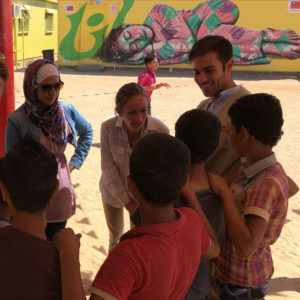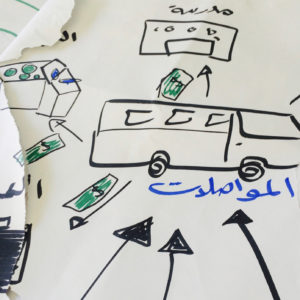Alice Bosley ’17 SIPA, is the Design Lead at the Design Studio@Columbia Entrepreneurship. Before moving to New York, she worked as an Innovation Specialist in UNHCR Innovation in Geneva, a unit in the UN Refugee Agency that uses human-centered design to solve humanitarian challenges worldwide. Alice graduated from Stanford in 2011, and is a current graduate student at Columbia’s School of International and Public Affairs (SIPA).
Alice Bosley
August 11, 2016
Last week, I went to Jordan with the Social Ventures Team at Mercy Corps to dig deeper into the realities of financial inclusion for Syrian refugees. My Mercy Corps colleague and I ran a series of focus group discussions and one-on-one interviews with refugees in three urban areas – East Amman, Mafraq, and Irbid – as well as Zaatari, the Middle East’s largest refugee camp .
Our conversations covered a number of difficult subjects: how easy was it for refugees to access basic services, like health care or legal support? How much did different types of documentation (i.e.: valid refugee registration card, or school or health records) play a role in people’s lives? How did refugees pay for services when legally they were not allowed to work? Discussing questions like these can be understandably tense, and so we relied on a variety of design thinking techniques to get our conversations started.

Walking into a focus group carrying giant pads of paper, markers, and post-it notes, I could have been walking into another day at the Design Studio@Columbia Entrepreneurship. After a brief introduction, we launched into active exercises to get everyone thinking more openly about their daily lives:
- Journeymapping: A journeymap is a diagram of a user’s process throughout an experience. This tool is useful for better understanding all of the steps in a specific process, but can also provide insights into highlights, lowlights, and potential contradictions in a process. We asked our focus groups to split into small teams and draw out their journey through different scenarios. For example, what steps would your family take if a member of your family were getting married? Or, what would you do if someone in your family were going to have a baby? Through drawing out the steps in their process, the participants provided us with insights into accessing loans, the legal system, and challenges in exiting the camps, among others.
- Resource Flows: Illustrating the resource flows into and out of households can be an excellent indicator of the financial health of a community, and can also highlight some of the pain points a household might face. We asked participants to map out their largest expense over the past six months, and how their family was able to pay for it. Participants mapped the types of income they received and the different ways in which it was spent, providing us with a clearer picture of the inner workings of their household.

- Group Brainstorming: What better way to learn together than to brainstorm together? To dig into the role of documentation in daily lives, we presented one focus group with a challenge: A man walks into a hospital after being hit on the head, and he has no memory of who he is. If the man is carrying a cell phone and a brief case, what are the different things we can look for to tell us who he is? The focus group did a rapid brainstorm of the different types of identification that we should look for to solve our ‘mystery’.

These creative techniques were a perfect way to ensure our participants were at ease, even having fun, while participating creatively in our focus groups. The activities allowed our focus group participants to share parts of their lives with us without having to speak up about personal subjects in front of a large group. Based on their explanations of their drawings, we were able to pinpoint areas we wanted to question further and to speak to specific individuals afterwards. Through these discussions we were able to learn an incredible amount about the daily lives, struggles, and successes of refugee communities.
For more information on user research, join our upcoming Introduction to User Research this Fall, or check out the Design Kit for some great ideas!


